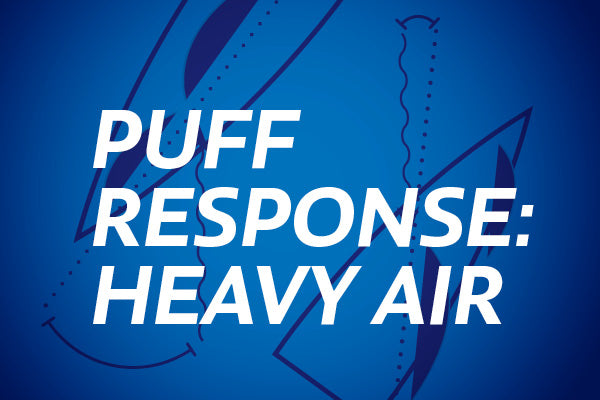PUFF RESPONSE UPWIND IN HEAVY AIR
PUFF RESPONSE UPWIND IN HEAVY AIR
By Bill Gladstone
This article is derived from the North U Trim Seminar. North U offers seminars, clinics, books, media, online training, and coaching. Visit NorthU.com to Learn More
Proper response to a puff is critical to optimum performance in variable conditions. In our previous segment, Puff Response Upwind, we covered the best response to a puff in moderate air. In this segment we’ll look at Puff Response Upwind in Heavy Air.
Heavy Air vs Moderate Air
We’ll start by drawing a distinction between heavy air and moderate air: In light to moderate conditions as the wind speed increases our boat speed increases. We define Heavy Air, at least for the purposes of this article, as winds where an increase in wind speed does not result in an increase in upwind boat speed. Many boats cross this threshold around 15 to 20 knots True Wind Speed.

Fig. 1: As the wind increases in heavy air our boat speed does not.
The Puff Hits
As a puff hits the True Wind increases (“GUST!”). The stronger True Wind creates a stronger Apparent Wind and a wider Apparent Wind Angle. The best response is to trim sails to match this wider Apparent Wind Angle – usually by lowering the traveler. The trim response maintains a balanced helm and consistent angle of heel.
It can be helpful if crew looking upwind can call or count down the arrival of puffs so the main trimmer and driver can be ready (“Puff in 3-2-1!”).
Ideally the jib would be eased in concert with the main but in reality that can be hard to do – and even harder to retrim. On boats where you can play the jib it can be very fast. J22s come to mind as one boat where the jib and main are both played through the puffs. See Figure 2.

Fig. 2: A puff results in stronger Apparent Wind and a wider Apparent Wind Angle. The proper initial response is a change in trim – lowering the traveler (or making other adjustments) to match the new wind angle.
Acceleration – NOT
The trim response maintains a balanced helm and consistent angle of heel. In heavy air we then feather up to point a little higher. Feathering up will push the apparent wind forward… See Figure 3.

Fig. 3: As we feather up in the new wind the apparent wind moves forward and we can re-trim.
Limits
You can feather up in puffs to a point… but your rig can never outpoint your keel. At some point you’ll be lowering the traveler (or adding twist or… see below) and leaving it down.
Wasted
If we don’t respond to the puff with a change in trim then we waste the energy of the puff in heeling force, weather helm and leeway rather than take advantage of it with a smooth feather up to a higher angle.
More…
Why a Trim Response? Why not just feather the helm?
Why not just feather through the puff? Because a Trim Response is faster. A trim response maintains a balanced helm and reduces leeway. A feathering response gives you a brief bit of height (usually accompanied by more heel and leeway). In actual practice your response will likely be a combination of both trim and feathering. Feathering alone will not be fast or sufficient in most conditions.
Why use the Traveler?
In this depiction we use the traveler to respond to a puff. Lowering the traveler reduces angle of attack. This is often the preferred method on a moderate displacement keel boat.
Alternatives to the Traveler
On some other boats – for example high performance boats with square top mains and high aspect keels, and on multi-hulls – it is more effective to play the mainsheet and change twist. On still others – for example, Etchells – a big pull on the backstay is very effective.
Some boats use “Vang Sheeting” (where the mainsheet controls angle of attack) and respond to puffs by playing the main.
Which is Best?
Snappy Answer: Whichever is fastest.
Longer Answer: You’ll have to test to see what works best on your boat; but the bottom line is that a Trim Response is preferred to just feathering/ steering through the puff.
Puff Response in Heavy Air
In actual practice your response will likely be a combination of trim and feathering. Feathering alone will not be fast or sufficient in most conditions.
© copyright Bill Gladstone



























